Organisational Behaviour and the Management of People - Report
VerifiedAdded on 2020/10/05
|12
|3260
|272
Report
AI Summary
This report delves into the realm of organisational behaviour, exploring key concepts such as leadership, motivation, and team building. It begins by defining these core elements and then proceeds to analyse various theories, including the Great Man Theory, Situational Theory, Vroom’s Expectancy Theory, Herzberg’s Two-Factor Theory, Tuckman Theory, and Belbin Theory. The report then examines the practical application of these theories within organisations, using the example of Airdri, a UK-based business. It highlights how the Tuckman theory can be used to build effective teams, fostering growth and achieving business objectives. The report emphasizes the importance of each stage of team development and how a manager can guide the team through the different phases. The report showcases the significance of understanding and applying organizational behaviour theories to enhance team performance, achieve goals, and effectively manage people within a business environment.
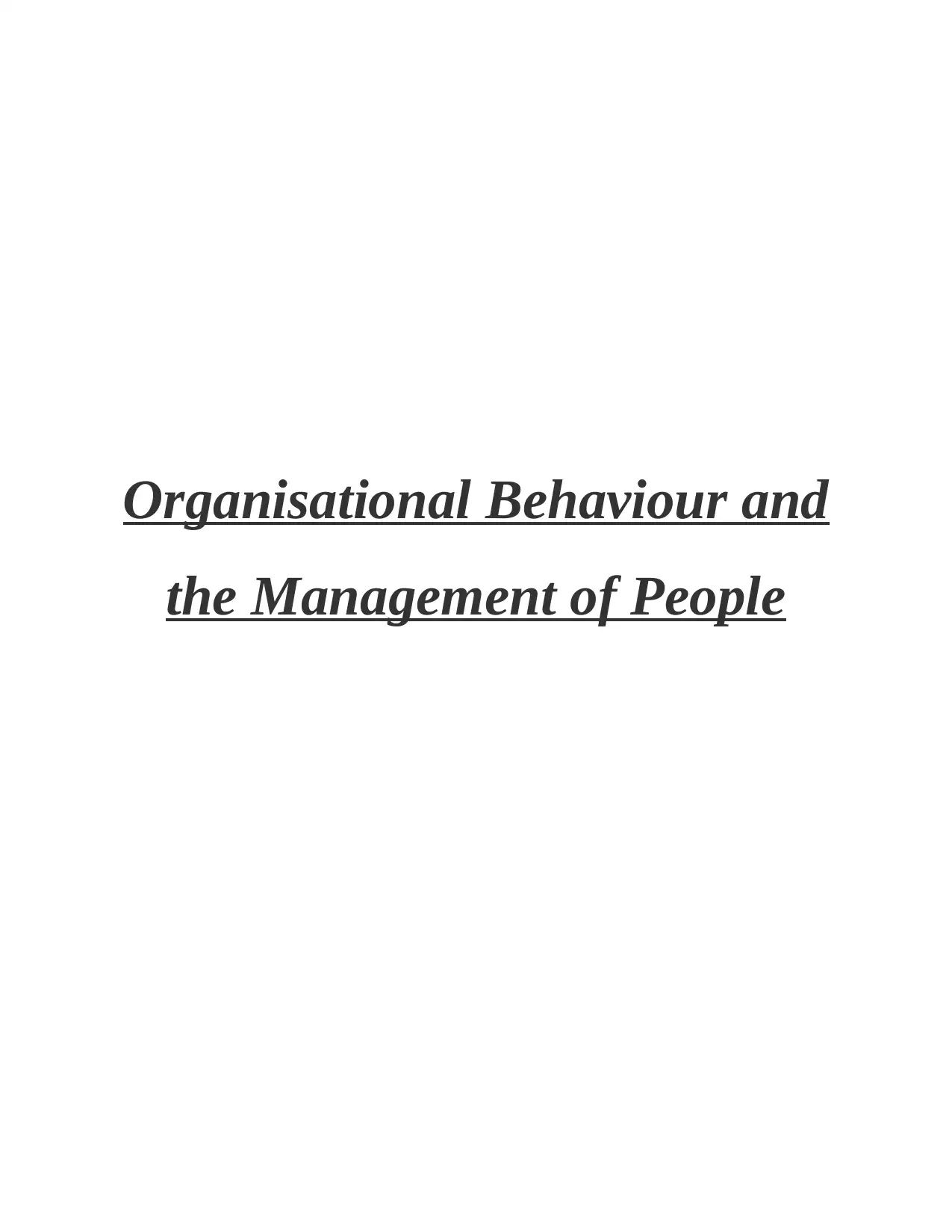
Organisational Behaviour and
the Management of People
the Management of People
Paraphrase This Document
Need a fresh take? Get an instant paraphrase of this document with our AI Paraphraser
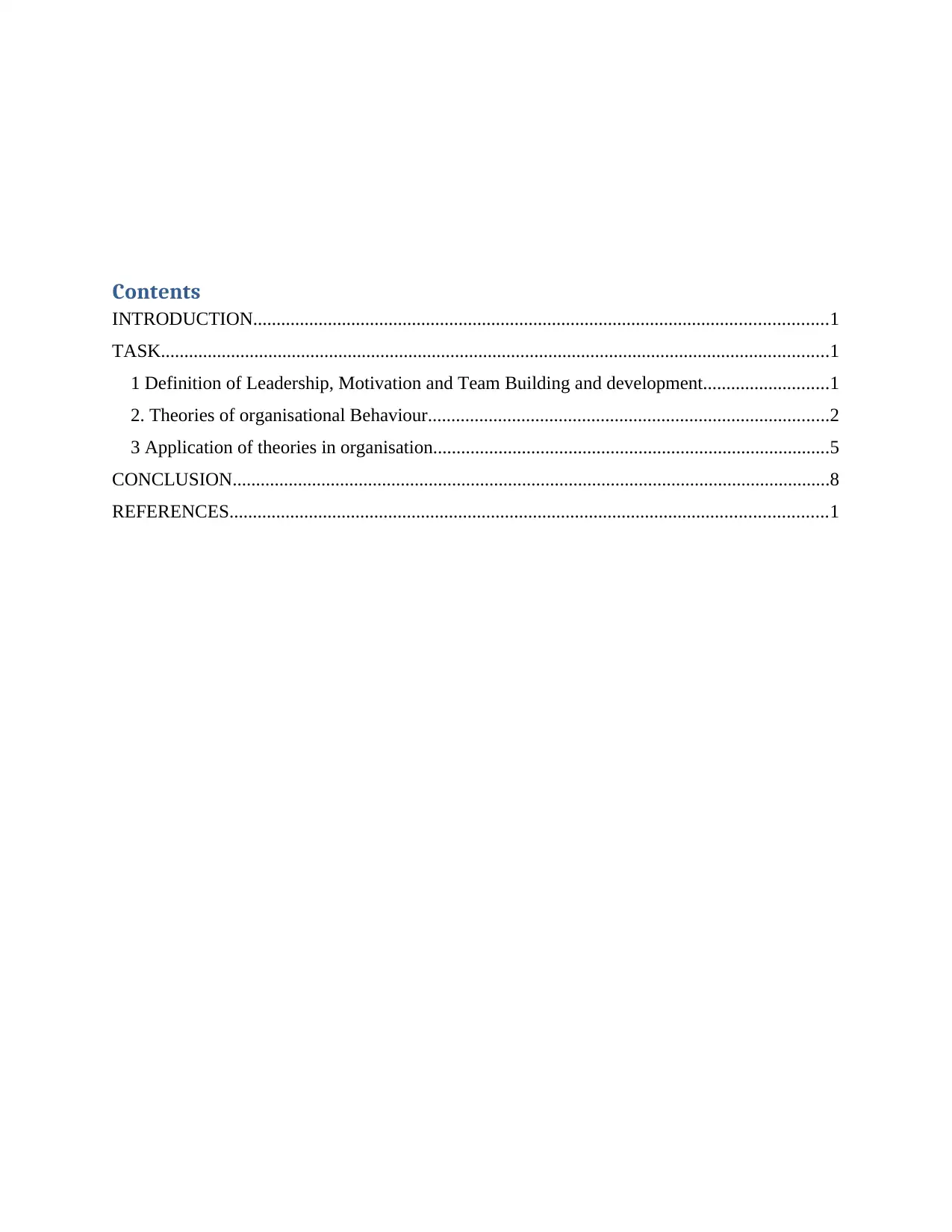
Contents
INTRODUCTION...........................................................................................................................1
TASK...............................................................................................................................................1
1 Definition of Leadership, Motivation and Team Building and development...........................1
2. Theories of organisational Behaviour......................................................................................2
3 Application of theories in organisation.....................................................................................5
CONCLUSION................................................................................................................................8
REFERENCES................................................................................................................................1
INTRODUCTION...........................................................................................................................1
TASK...............................................................................................................................................1
1 Definition of Leadership, Motivation and Team Building and development...........................1
2. Theories of organisational Behaviour......................................................................................2
3 Application of theories in organisation.....................................................................................5
CONCLUSION................................................................................................................................8
REFERENCES................................................................................................................................1
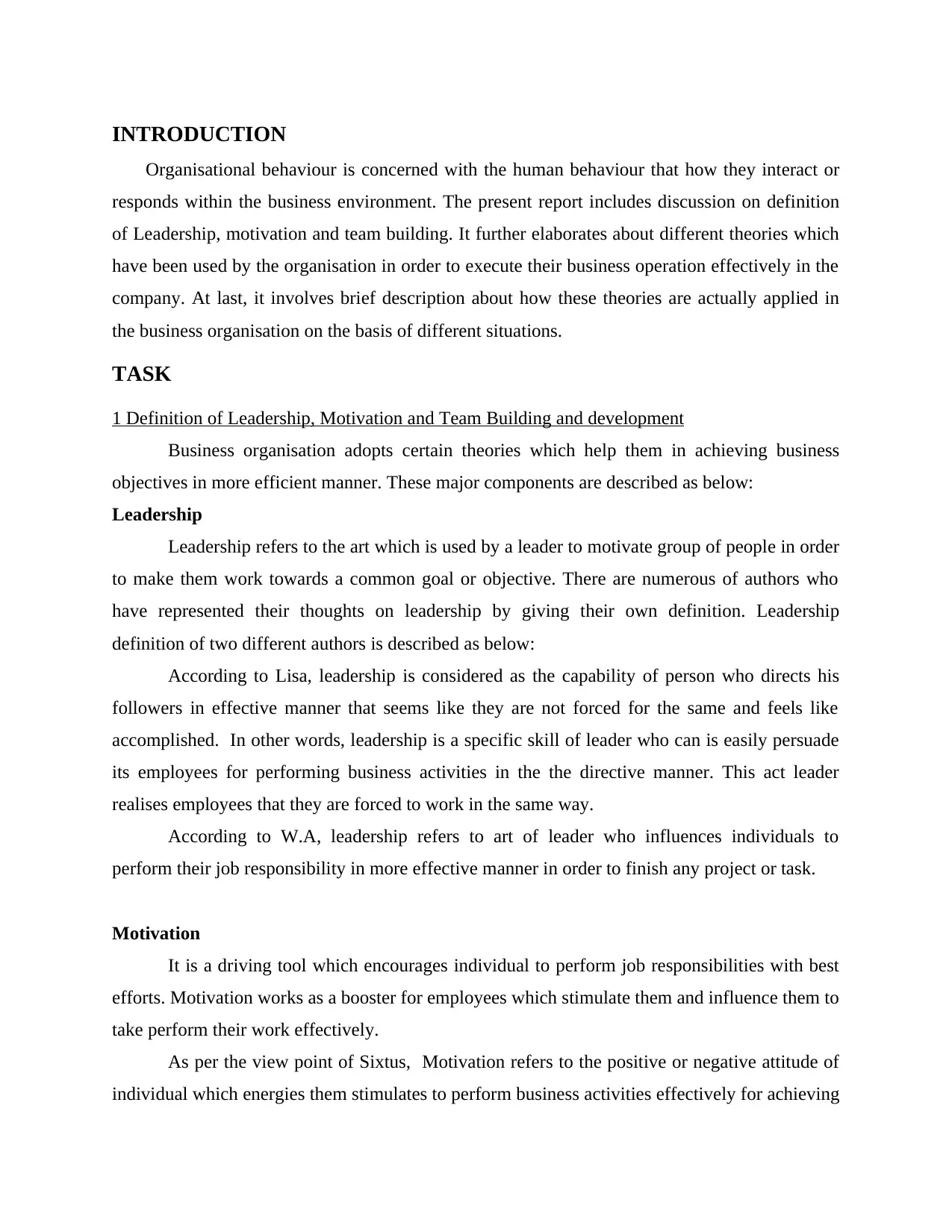
INTRODUCTION
Organisational behaviour is concerned with the human behaviour that how they interact or
responds within the business environment. The present report includes discussion on definition
of Leadership, motivation and team building. It further elaborates about different theories which
have been used by the organisation in order to execute their business operation effectively in the
company. At last, it involves brief description about how these theories are actually applied in
the business organisation on the basis of different situations.
TASK
1 Definition of Leadership, Motivation and Team Building and development
Business organisation adopts certain theories which help them in achieving business
objectives in more efficient manner. These major components are described as below:
Leadership
Leadership refers to the art which is used by a leader to motivate group of people in order
to make them work towards a common goal or objective. There are numerous of authors who
have represented their thoughts on leadership by giving their own definition. Leadership
definition of two different authors is described as below:
According to Lisa, leadership is considered as the capability of person who directs his
followers in effective manner that seems like they are not forced for the same and feels like
accomplished. In other words, leadership is a specific skill of leader who can is easily persuade
its employees for performing business activities in the the directive manner. This act leader
realises employees that they are forced to work in the same way.
According to W.A, leadership refers to art of leader who influences individuals to
perform their job responsibility in more effective manner in order to finish any project or task.
Motivation
It is a driving tool which encourages individual to perform job responsibilities with best
efforts. Motivation works as a booster for employees which stimulate them and influence them to
take perform their work effectively.
As per the view point of Sixtus, Motivation refers to the positive or negative attitude of
individual which energies them stimulates to perform business activities effectively for achieving
Organisational behaviour is concerned with the human behaviour that how they interact or
responds within the business environment. The present report includes discussion on definition
of Leadership, motivation and team building. It further elaborates about different theories which
have been used by the organisation in order to execute their business operation effectively in the
company. At last, it involves brief description about how these theories are actually applied in
the business organisation on the basis of different situations.
TASK
1 Definition of Leadership, Motivation and Team Building and development
Business organisation adopts certain theories which help them in achieving business
objectives in more efficient manner. These major components are described as below:
Leadership
Leadership refers to the art which is used by a leader to motivate group of people in order
to make them work towards a common goal or objective. There are numerous of authors who
have represented their thoughts on leadership by giving their own definition. Leadership
definition of two different authors is described as below:
According to Lisa, leadership is considered as the capability of person who directs his
followers in effective manner that seems like they are not forced for the same and feels like
accomplished. In other words, leadership is a specific skill of leader who can is easily persuade
its employees for performing business activities in the the directive manner. This act leader
realises employees that they are forced to work in the same way.
According to W.A, leadership refers to art of leader who influences individuals to
perform their job responsibility in more effective manner in order to finish any project or task.
Motivation
It is a driving tool which encourages individual to perform job responsibilities with best
efforts. Motivation works as a booster for employees which stimulate them and influence them to
take perform their work effectively.
As per the view point of Sixtus, Motivation refers to the positive or negative attitude of
individual which energies them stimulates to perform business activities effectively for achieving
⊘ This is a preview!⊘
Do you want full access?
Subscribe today to unlock all pages.

Trusted by 1+ million students worldwide
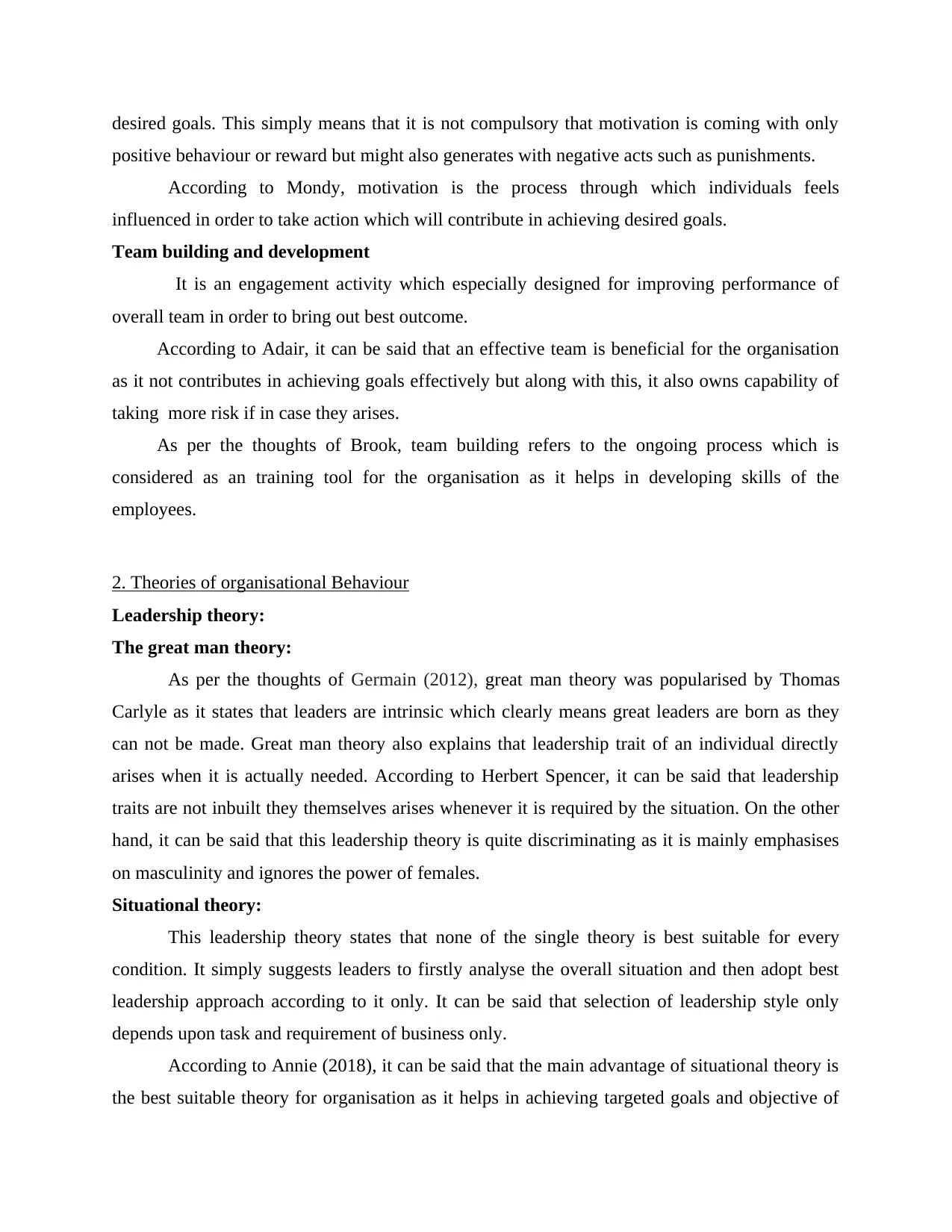
desired goals. This simply means that it is not compulsory that motivation is coming with only
positive behaviour or reward but might also generates with negative acts such as punishments.
According to Mondy, motivation is the process through which individuals feels
influenced in order to take action which will contribute in achieving desired goals.
Team building and development
It is an engagement activity which especially designed for improving performance of
overall team in order to bring out best outcome.
According to Adair, it can be said that an effective team is beneficial for the organisation
as it not contributes in achieving goals effectively but along with this, it also owns capability of
taking more risk if in case they arises.
As per the thoughts of Brook, team building refers to the ongoing process which is
considered as an training tool for the organisation as it helps in developing skills of the
employees.
2. Theories of organisational Behaviour
Leadership theory:
The great man theory:
As per the thoughts of Germain (2012), great man theory was popularised by Thomas
Carlyle as it states that leaders are intrinsic which clearly means great leaders are born as they
can not be made. Great man theory also explains that leadership trait of an individual directly
arises when it is actually needed. According to Herbert Spencer, it can be said that leadership
traits are not inbuilt they themselves arises whenever it is required by the situation. On the other
hand, it can be said that this leadership theory is quite discriminating as it is mainly emphasises
on masculinity and ignores the power of females.
Situational theory:
This leadership theory states that none of the single theory is best suitable for every
condition. It simply suggests leaders to firstly analyse the overall situation and then adopt best
leadership approach according to it only. It can be said that selection of leadership style only
depends upon task and requirement of business only.
According to Annie (2018), it can be said that the main advantage of situational theory is
the best suitable theory for organisation as it helps in achieving targeted goals and objective of
positive behaviour or reward but might also generates with negative acts such as punishments.
According to Mondy, motivation is the process through which individuals feels
influenced in order to take action which will contribute in achieving desired goals.
Team building and development
It is an engagement activity which especially designed for improving performance of
overall team in order to bring out best outcome.
According to Adair, it can be said that an effective team is beneficial for the organisation
as it not contributes in achieving goals effectively but along with this, it also owns capability of
taking more risk if in case they arises.
As per the thoughts of Brook, team building refers to the ongoing process which is
considered as an training tool for the organisation as it helps in developing skills of the
employees.
2. Theories of organisational Behaviour
Leadership theory:
The great man theory:
As per the thoughts of Germain (2012), great man theory was popularised by Thomas
Carlyle as it states that leaders are intrinsic which clearly means great leaders are born as they
can not be made. Great man theory also explains that leadership trait of an individual directly
arises when it is actually needed. According to Herbert Spencer, it can be said that leadership
traits are not inbuilt they themselves arises whenever it is required by the situation. On the other
hand, it can be said that this leadership theory is quite discriminating as it is mainly emphasises
on masculinity and ignores the power of females.
Situational theory:
This leadership theory states that none of the single theory is best suitable for every
condition. It simply suggests leaders to firstly analyse the overall situation and then adopt best
leadership approach according to it only. It can be said that selection of leadership style only
depends upon task and requirement of business only.
According to Annie (2018), it can be said that the main advantage of situational theory is
the best suitable theory for organisation as it helps in achieving targeted goals and objective of
Paraphrase This Document
Need a fresh take? Get an instant paraphrase of this document with our AI Paraphraser
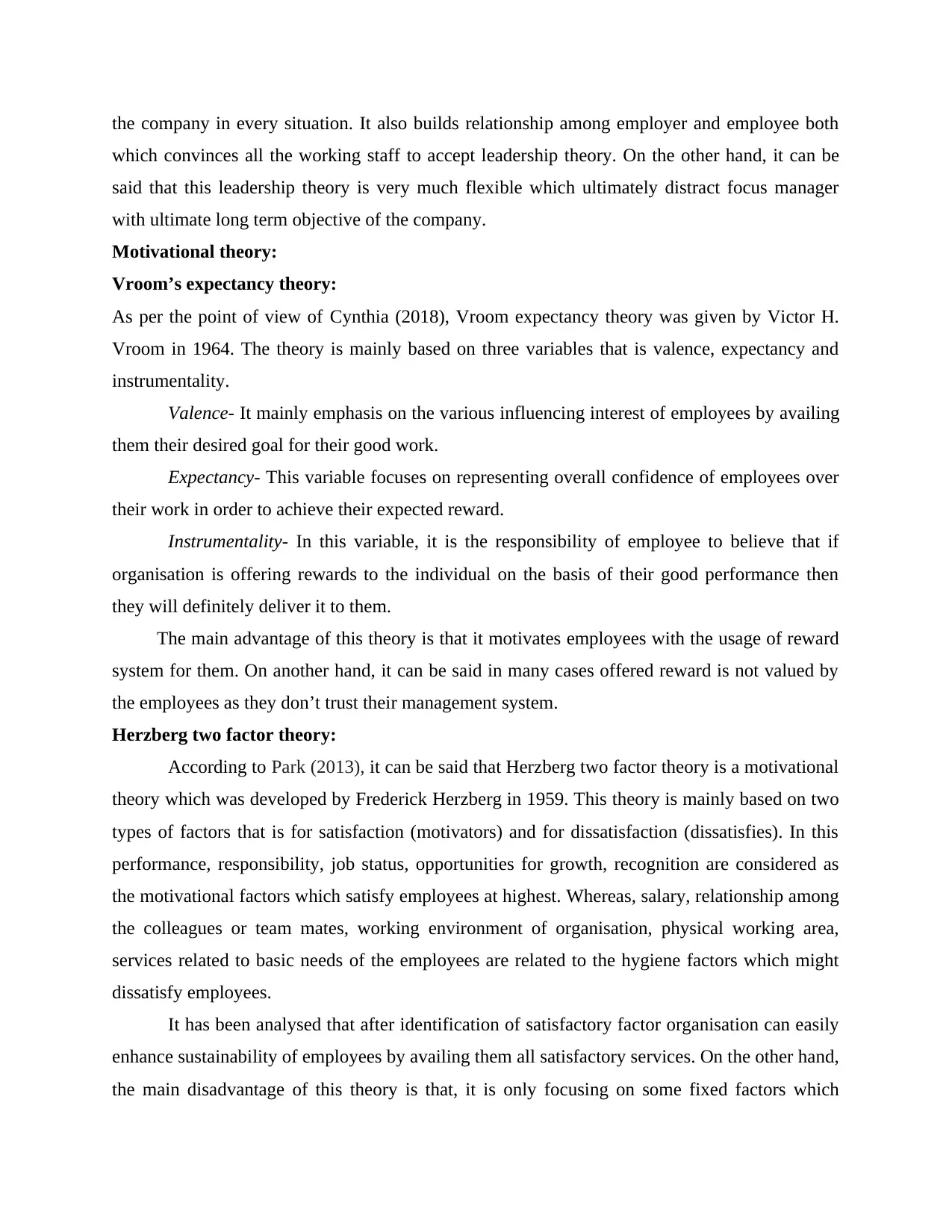
the company in every situation. It also builds relationship among employer and employee both
which convinces all the working staff to accept leadership theory. On the other hand, it can be
said that this leadership theory is very much flexible which ultimately distract focus manager
with ultimate long term objective of the company.
Motivational theory:
Vroom’s expectancy theory:
As per the point of view of Cynthia (2018), Vroom expectancy theory was given by Victor H.
Vroom in 1964. The theory is mainly based on three variables that is valence, expectancy and
instrumentality.
Valence- It mainly emphasis on the various influencing interest of employees by availing
them their desired goal for their good work.
Expectancy- This variable focuses on representing overall confidence of employees over
their work in order to achieve their expected reward.
Instrumentality- In this variable, it is the responsibility of employee to believe that if
organisation is offering rewards to the individual on the basis of their good performance then
they will definitely deliver it to them.
The main advantage of this theory is that it motivates employees with the usage of reward
system for them. On another hand, it can be said in many cases offered reward is not valued by
the employees as they don’t trust their management system.
Herzberg two factor theory:
According to Park (2013), it can be said that Herzberg two factor theory is a motivational
theory which was developed by Frederick Herzberg in 1959. This theory is mainly based on two
types of factors that is for satisfaction (motivators) and for dissatisfaction (dissatisfies). In this
performance, responsibility, job status, opportunities for growth, recognition are considered as
the motivational factors which satisfy employees at highest. Whereas, salary, relationship among
the colleagues or team mates, working environment of organisation, physical working area,
services related to basic needs of the employees are related to the hygiene factors which might
dissatisfy employees.
It has been analysed that after identification of satisfactory factor organisation can easily
enhance sustainability of employees by availing them all satisfactory services. On the other hand,
the main disadvantage of this theory is that, it is only focusing on some fixed factors which
which convinces all the working staff to accept leadership theory. On the other hand, it can be
said that this leadership theory is very much flexible which ultimately distract focus manager
with ultimate long term objective of the company.
Motivational theory:
Vroom’s expectancy theory:
As per the point of view of Cynthia (2018), Vroom expectancy theory was given by Victor H.
Vroom in 1964. The theory is mainly based on three variables that is valence, expectancy and
instrumentality.
Valence- It mainly emphasis on the various influencing interest of employees by availing
them their desired goal for their good work.
Expectancy- This variable focuses on representing overall confidence of employees over
their work in order to achieve their expected reward.
Instrumentality- In this variable, it is the responsibility of employee to believe that if
organisation is offering rewards to the individual on the basis of their good performance then
they will definitely deliver it to them.
The main advantage of this theory is that it motivates employees with the usage of reward
system for them. On another hand, it can be said in many cases offered reward is not valued by
the employees as they don’t trust their management system.
Herzberg two factor theory:
According to Park (2013), it can be said that Herzberg two factor theory is a motivational
theory which was developed by Frederick Herzberg in 1959. This theory is mainly based on two
types of factors that is for satisfaction (motivators) and for dissatisfaction (dissatisfies). In this
performance, responsibility, job status, opportunities for growth, recognition are considered as
the motivational factors which satisfy employees at highest. Whereas, salary, relationship among
the colleagues or team mates, working environment of organisation, physical working area,
services related to basic needs of the employees are related to the hygiene factors which might
dissatisfy employees.
It has been analysed that after identification of satisfactory factor organisation can easily
enhance sustainability of employees by availing them all satisfactory services. On the other hand,
the main disadvantage of this theory is that, it is only focusing on some fixed factors which
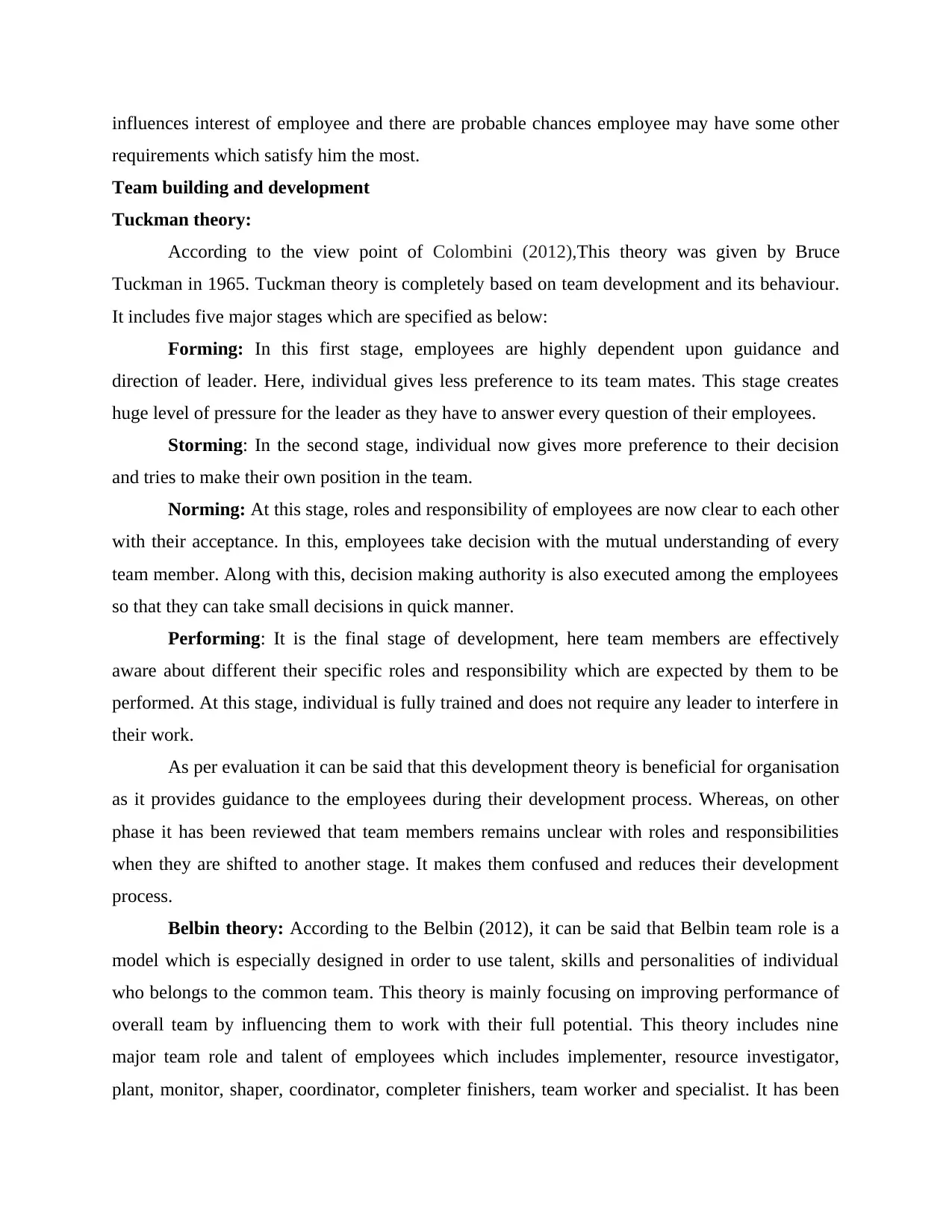
influences interest of employee and there are probable chances employee may have some other
requirements which satisfy him the most.
Team building and development
Tuckman theory:
According to the view point of Colombini (2012),This theory was given by Bruce
Tuckman in 1965. Tuckman theory is completely based on team development and its behaviour.
It includes five major stages which are specified as below:
Forming: In this first stage, employees are highly dependent upon guidance and
direction of leader. Here, individual gives less preference to its team mates. This stage creates
huge level of pressure for the leader as they have to answer every question of their employees.
Storming: In the second stage, individual now gives more preference to their decision
and tries to make their own position in the team.
Norming: At this stage, roles and responsibility of employees are now clear to each other
with their acceptance. In this, employees take decision with the mutual understanding of every
team member. Along with this, decision making authority is also executed among the employees
so that they can take small decisions in quick manner.
Performing: It is the final stage of development, here team members are effectively
aware about different their specific roles and responsibility which are expected by them to be
performed. At this stage, individual is fully trained and does not require any leader to interfere in
their work.
As per evaluation it can be said that this development theory is beneficial for organisation
as it provides guidance to the employees during their development process. Whereas, on other
phase it has been reviewed that team members remains unclear with roles and responsibilities
when they are shifted to another stage. It makes them confused and reduces their development
process.
Belbin theory: According to the Belbin (2012), it can be said that Belbin team role is a
model which is especially designed in order to use talent, skills and personalities of individual
who belongs to the common team. This theory is mainly focusing on improving performance of
overall team by influencing them to work with their full potential. This theory includes nine
major team role and talent of employees which includes implementer, resource investigator,
plant, monitor, shaper, coordinator, completer finishers, team worker and specialist. It has been
requirements which satisfy him the most.
Team building and development
Tuckman theory:
According to the view point of Colombini (2012),This theory was given by Bruce
Tuckman in 1965. Tuckman theory is completely based on team development and its behaviour.
It includes five major stages which are specified as below:
Forming: In this first stage, employees are highly dependent upon guidance and
direction of leader. Here, individual gives less preference to its team mates. This stage creates
huge level of pressure for the leader as they have to answer every question of their employees.
Storming: In the second stage, individual now gives more preference to their decision
and tries to make their own position in the team.
Norming: At this stage, roles and responsibility of employees are now clear to each other
with their acceptance. In this, employees take decision with the mutual understanding of every
team member. Along with this, decision making authority is also executed among the employees
so that they can take small decisions in quick manner.
Performing: It is the final stage of development, here team members are effectively
aware about different their specific roles and responsibility which are expected by them to be
performed. At this stage, individual is fully trained and does not require any leader to interfere in
their work.
As per evaluation it can be said that this development theory is beneficial for organisation
as it provides guidance to the employees during their development process. Whereas, on other
phase it has been reviewed that team members remains unclear with roles and responsibilities
when they are shifted to another stage. It makes them confused and reduces their development
process.
Belbin theory: According to the Belbin (2012), it can be said that Belbin team role is a
model which is especially designed in order to use talent, skills and personalities of individual
who belongs to the common team. This theory is mainly focusing on improving performance of
overall team by influencing them to work with their full potential. This theory includes nine
major team role and talent of employees which includes implementer, resource investigator,
plant, monitor, shaper, coordinator, completer finishers, team worker and specialist. It has been
⊘ This is a preview!⊘
Do you want full access?
Subscribe today to unlock all pages.

Trusted by 1+ million students worldwide
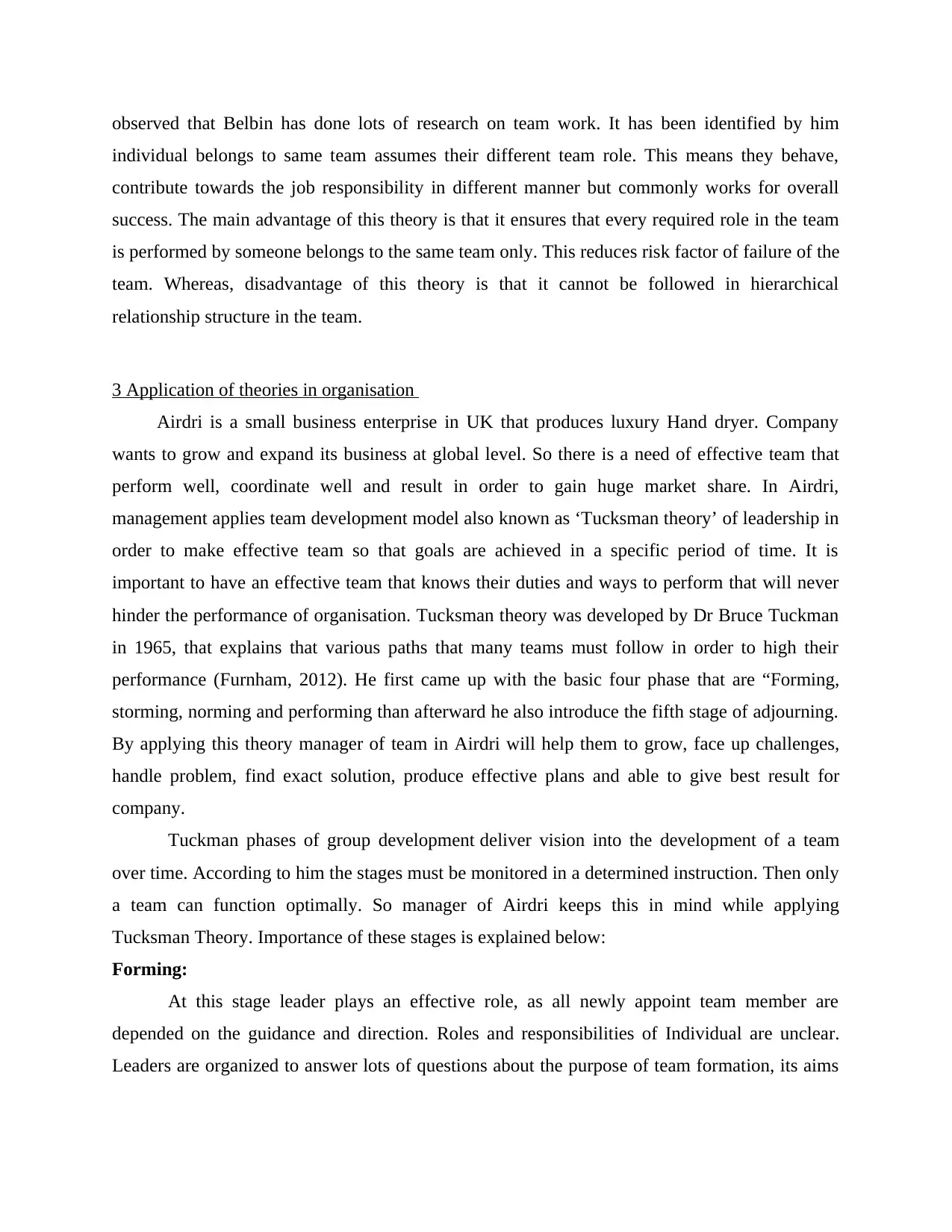
observed that Belbin has done lots of research on team work. It has been identified by him
individual belongs to same team assumes their different team role. This means they behave,
contribute towards the job responsibility in different manner but commonly works for overall
success. The main advantage of this theory is that it ensures that every required role in the team
is performed by someone belongs to the same team only. This reduces risk factor of failure of the
team. Whereas, disadvantage of this theory is that it cannot be followed in hierarchical
relationship structure in the team.
3 Application of theories in organisation
Airdri is a small business enterprise in UK that produces luxury Hand dryer. Company
wants to grow and expand its business at global level. So there is a need of effective team that
perform well, coordinate well and result in order to gain huge market share. In Airdri,
management applies team development model also known as ‘Tucksman theory’ of leadership in
order to make effective team so that goals are achieved in a specific period of time. It is
important to have an effective team that knows their duties and ways to perform that will never
hinder the performance of organisation. Tucksman theory was developed by Dr Bruce Tuckman
in 1965, that explains that various paths that many teams must follow in order to high their
performance (Furnham, 2012). He first came up with the basic four phase that are “Forming,
storming, norming and performing than afterward he also introduce the fifth stage of adjourning.
By applying this theory manager of team in Airdri will help them to grow, face up challenges,
handle problem, find exact solution, produce effective plans and able to give best result for
company.
Tuckman phases of group development deliver vision into the development of a team
over time. According to him the stages must be monitored in a determined instruction. Then only
a team can function optimally. So manager of Airdri keeps this in mind while applying
Tucksman Theory. Importance of these stages is explained below:
Forming:
At this stage leader plays an effective role, as all newly appoint team member are
depended on the guidance and direction. Roles and responsibilities of Individual are unclear.
Leaders are organized to answer lots of questions about the purpose of team formation, its aims
individual belongs to same team assumes their different team role. This means they behave,
contribute towards the job responsibility in different manner but commonly works for overall
success. The main advantage of this theory is that it ensures that every required role in the team
is performed by someone belongs to the same team only. This reduces risk factor of failure of the
team. Whereas, disadvantage of this theory is that it cannot be followed in hierarchical
relationship structure in the team.
3 Application of theories in organisation
Airdri is a small business enterprise in UK that produces luxury Hand dryer. Company
wants to grow and expand its business at global level. So there is a need of effective team that
perform well, coordinate well and result in order to gain huge market share. In Airdri,
management applies team development model also known as ‘Tucksman theory’ of leadership in
order to make effective team so that goals are achieved in a specific period of time. It is
important to have an effective team that knows their duties and ways to perform that will never
hinder the performance of organisation. Tucksman theory was developed by Dr Bruce Tuckman
in 1965, that explains that various paths that many teams must follow in order to high their
performance (Furnham, 2012). He first came up with the basic four phase that are “Forming,
storming, norming and performing than afterward he also introduce the fifth stage of adjourning.
By applying this theory manager of team in Airdri will help them to grow, face up challenges,
handle problem, find exact solution, produce effective plans and able to give best result for
company.
Tuckman phases of group development deliver vision into the development of a team
over time. According to him the stages must be monitored in a determined instruction. Then only
a team can function optimally. So manager of Airdri keeps this in mind while applying
Tucksman Theory. Importance of these stages is explained below:
Forming:
At this stage leader plays an effective role, as all newly appoint team member are
depended on the guidance and direction. Roles and responsibilities of Individual are unclear.
Leaders are organized to answer lots of questions about the purpose of team formation, its aims
Paraphrase This Document
Need a fresh take? Get an instant paraphrase of this document with our AI Paraphraser
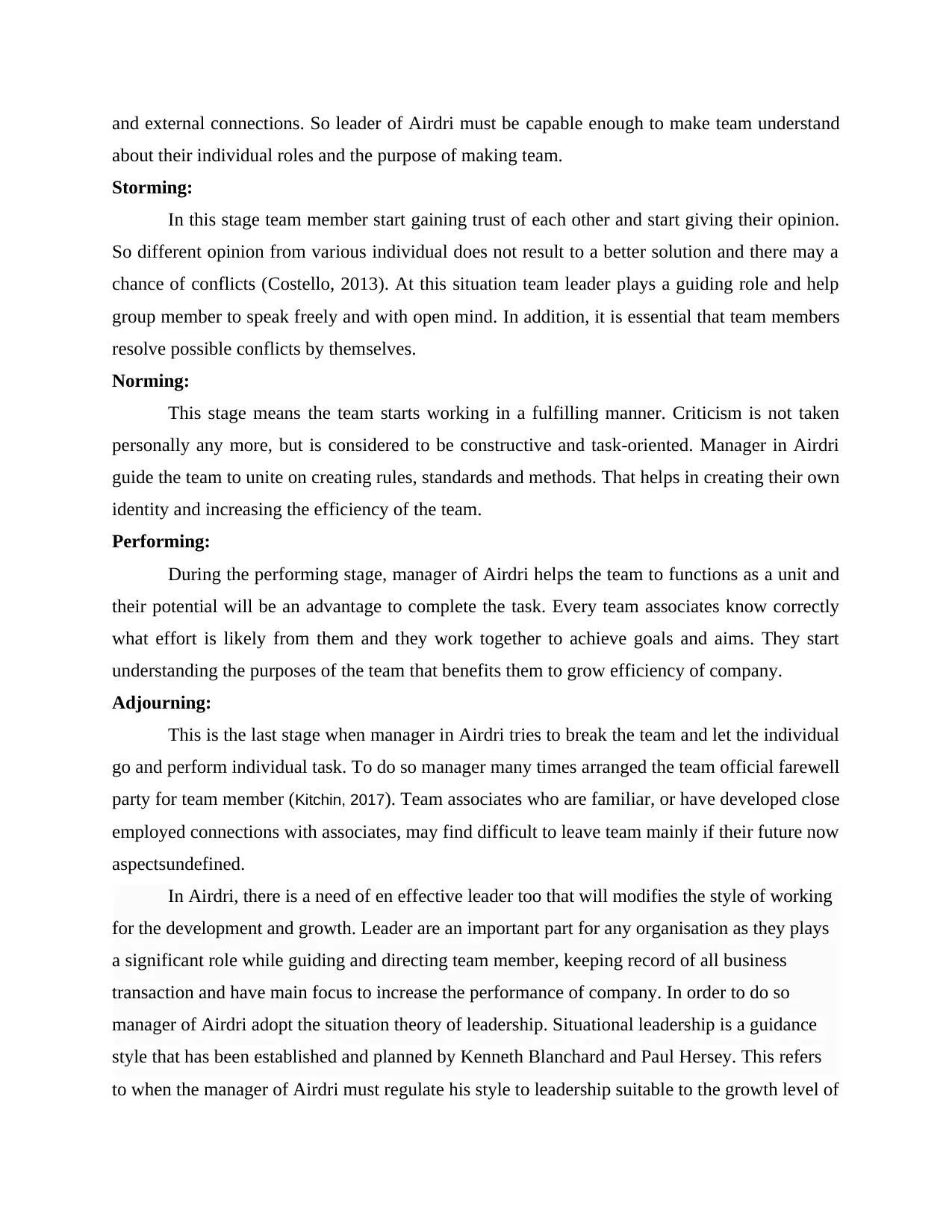
and external connections. So leader of Airdri must be capable enough to make team understand
about their individual roles and the purpose of making team.
Storming:
In this stage team member start gaining trust of each other and start giving their opinion.
So different opinion from various individual does not result to a better solution and there may a
chance of conflicts (Costello, 2013). At this situation team leader plays a guiding role and help
group member to speak freely and with open mind. In addition, it is essential that team members
resolve possible conflicts by themselves.
Norming:
This stage means the team starts working in a fulfilling manner. Criticism is not taken
personally any more, but is considered to be constructive and task-oriented. Manager in Airdri
guide the team to unite on creating rules, standards and methods. That helps in creating their own
identity and increasing the efficiency of the team.
Performing:
During the performing stage, manager of Airdri helps the team to functions as a unit and
their potential will be an advantage to complete the task. Every team associates know correctly
what effort is likely from them and they work together to achieve goals and aims. They start
understanding the purposes of the team that benefits them to grow efficiency of company.
Adjourning:
This is the last stage when manager in Airdri tries to break the team and let the individual
go and perform individual task. To do so manager many times arranged the team official farewell
party for team member (Kitchin, 2017). Team associates who are familiar, or have developed close
employed connections with associates, may find difficult to leave team mainly if their future now
aspectsundefined.
In Airdri, there is a need of en effective leader too that will modifies the style of working
for the development and growth. Leader are an important part for any organisation as they plays
a significant role while guiding and directing team member, keeping record of all business
transaction and have main focus to increase the performance of company. In order to do so
manager of Airdri adopt the situation theory of leadership. Situational leadership is a guidance
style that has been established and planned by Kenneth Blanchard and Paul Hersey. This refers
to when the manager of Airdri must regulate his style to leadership suitable to the growth level of
about their individual roles and the purpose of making team.
Storming:
In this stage team member start gaining trust of each other and start giving their opinion.
So different opinion from various individual does not result to a better solution and there may a
chance of conflicts (Costello, 2013). At this situation team leader plays a guiding role and help
group member to speak freely and with open mind. In addition, it is essential that team members
resolve possible conflicts by themselves.
Norming:
This stage means the team starts working in a fulfilling manner. Criticism is not taken
personally any more, but is considered to be constructive and task-oriented. Manager in Airdri
guide the team to unite on creating rules, standards and methods. That helps in creating their own
identity and increasing the efficiency of the team.
Performing:
During the performing stage, manager of Airdri helps the team to functions as a unit and
their potential will be an advantage to complete the task. Every team associates know correctly
what effort is likely from them and they work together to achieve goals and aims. They start
understanding the purposes of the team that benefits them to grow efficiency of company.
Adjourning:
This is the last stage when manager in Airdri tries to break the team and let the individual
go and perform individual task. To do so manager many times arranged the team official farewell
party for team member (Kitchin, 2017). Team associates who are familiar, or have developed close
employed connections with associates, may find difficult to leave team mainly if their future now
aspectsundefined.
In Airdri, there is a need of en effective leader too that will modifies the style of working
for the development and growth. Leader are an important part for any organisation as they plays
a significant role while guiding and directing team member, keeping record of all business
transaction and have main focus to increase the performance of company. In order to do so
manager of Airdri adopt the situation theory of leadership. Situational leadership is a guidance
style that has been established and planned by Kenneth Blanchard and Paul Hersey. This refers
to when the manager of Airdri must regulate his style to leadership suitable to the growth level of
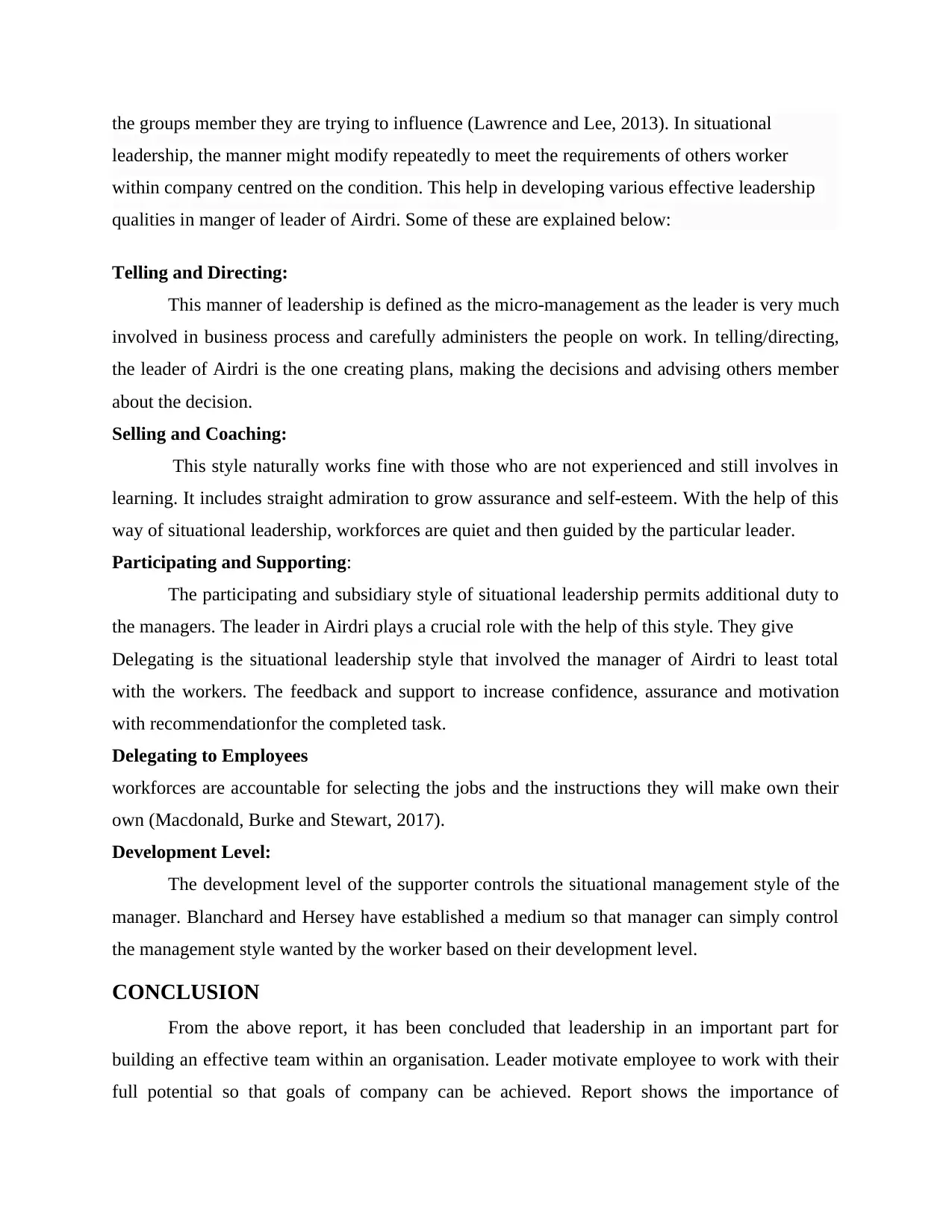
the groups member they are trying to influence (Lawrence and Lee, 2013). In situational
leadership, the manner might modify repeatedly to meet the requirements of others worker
within company centred on the condition. This help in developing various effective leadership
qualities in manger of leader of Airdri. Some of these are explained below:
Telling and Directing:
This manner of leadership is defined as the micro-management as the leader is very much
involved in business process and carefully administers the people on work. In telling/directing,
the leader of Airdri is the one creating plans, making the decisions and advising others member
about the decision.
Selling and Coaching:
This style naturally works fine with those who are not experienced and still involves in
learning. It includes straight admiration to grow assurance and self-esteem. With the help of this
way of situational leadership, workforces are quiet and then guided by the particular leader.
Participating and Supporting:
The participating and subsidiary style of situational leadership permits additional duty to
the managers. The leader in Airdri plays a crucial role with the help of this style. They give
Delegating is the situational leadership style that involved the manager of Airdri to least total
with the workers. The feedback and support to increase confidence, assurance and motivation
with recommendationfor the completed task.
Delegating to Employees
workforces are accountable for selecting the jobs and the instructions they will make own their
own (Macdonald, Burke and Stewart, 2017).
Development Level:
The development level of the supporter controls the situational management style of the
manager. Blanchard and Hersey have established a medium so that manager can simply control
the management style wanted by the worker based on their development level.
CONCLUSION
From the above report, it has been concluded that leadership in an important part for
building an effective team within an organisation. Leader motivate employee to work with their
full potential so that goals of company can be achieved. Report shows the importance of
leadership, the manner might modify repeatedly to meet the requirements of others worker
within company centred on the condition. This help in developing various effective leadership
qualities in manger of leader of Airdri. Some of these are explained below:
Telling and Directing:
This manner of leadership is defined as the micro-management as the leader is very much
involved in business process and carefully administers the people on work. In telling/directing,
the leader of Airdri is the one creating plans, making the decisions and advising others member
about the decision.
Selling and Coaching:
This style naturally works fine with those who are not experienced and still involves in
learning. It includes straight admiration to grow assurance and self-esteem. With the help of this
way of situational leadership, workforces are quiet and then guided by the particular leader.
Participating and Supporting:
The participating and subsidiary style of situational leadership permits additional duty to
the managers. The leader in Airdri plays a crucial role with the help of this style. They give
Delegating is the situational leadership style that involved the manager of Airdri to least total
with the workers. The feedback and support to increase confidence, assurance and motivation
with recommendationfor the completed task.
Delegating to Employees
workforces are accountable for selecting the jobs and the instructions they will make own their
own (Macdonald, Burke and Stewart, 2017).
Development Level:
The development level of the supporter controls the situational management style of the
manager. Blanchard and Hersey have established a medium so that manager can simply control
the management style wanted by the worker based on their development level.
CONCLUSION
From the above report, it has been concluded that leadership in an important part for
building an effective team within an organisation. Leader motivate employee to work with their
full potential so that goals of company can be achieved. Report shows the importance of
⊘ This is a preview!⊘
Do you want full access?
Subscribe today to unlock all pages.

Trusted by 1+ million students worldwide
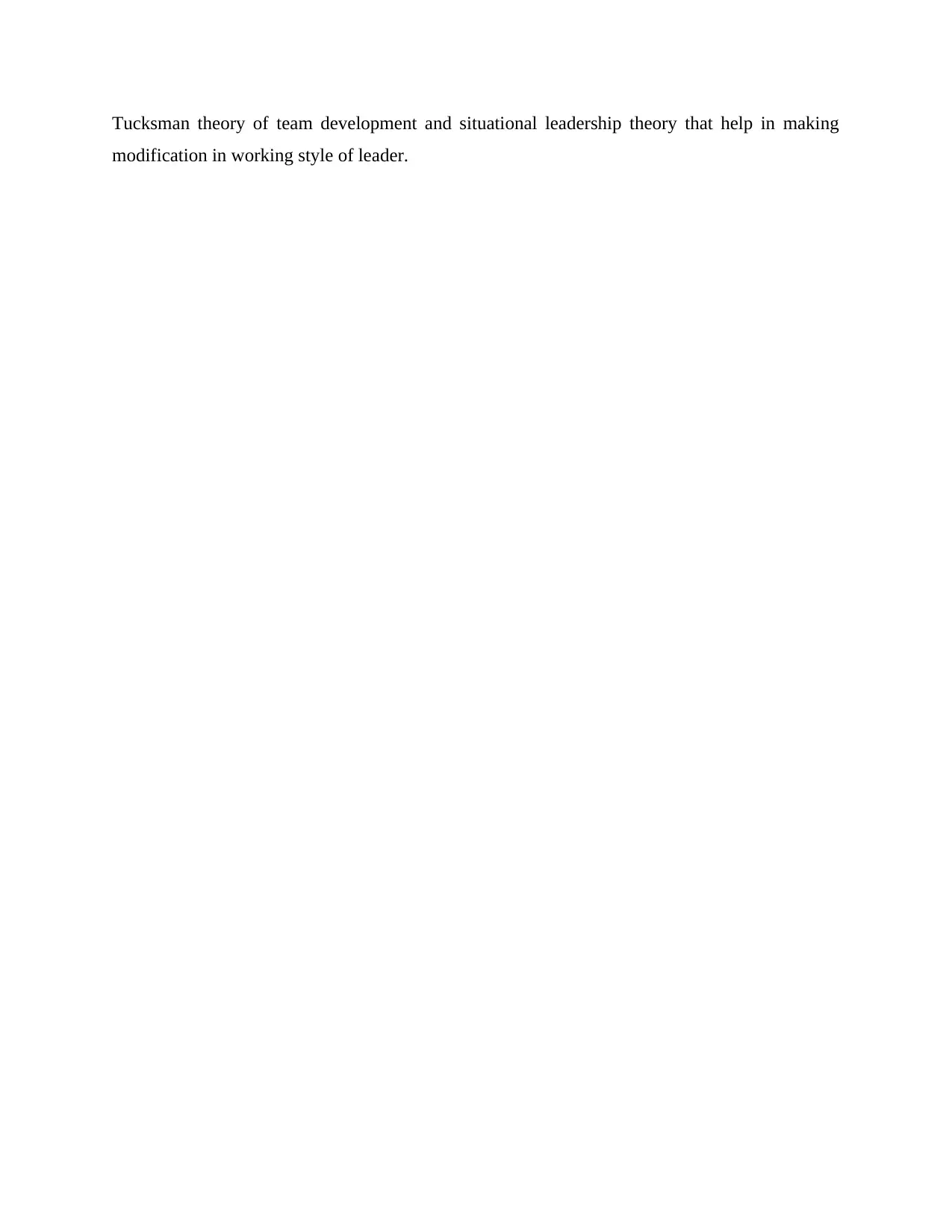
Tucksman theory of team development and situational leadership theory that help in making
modification in working style of leader.
modification in working style of leader.
Paraphrase This Document
Need a fresh take? Get an instant paraphrase of this document with our AI Paraphraser
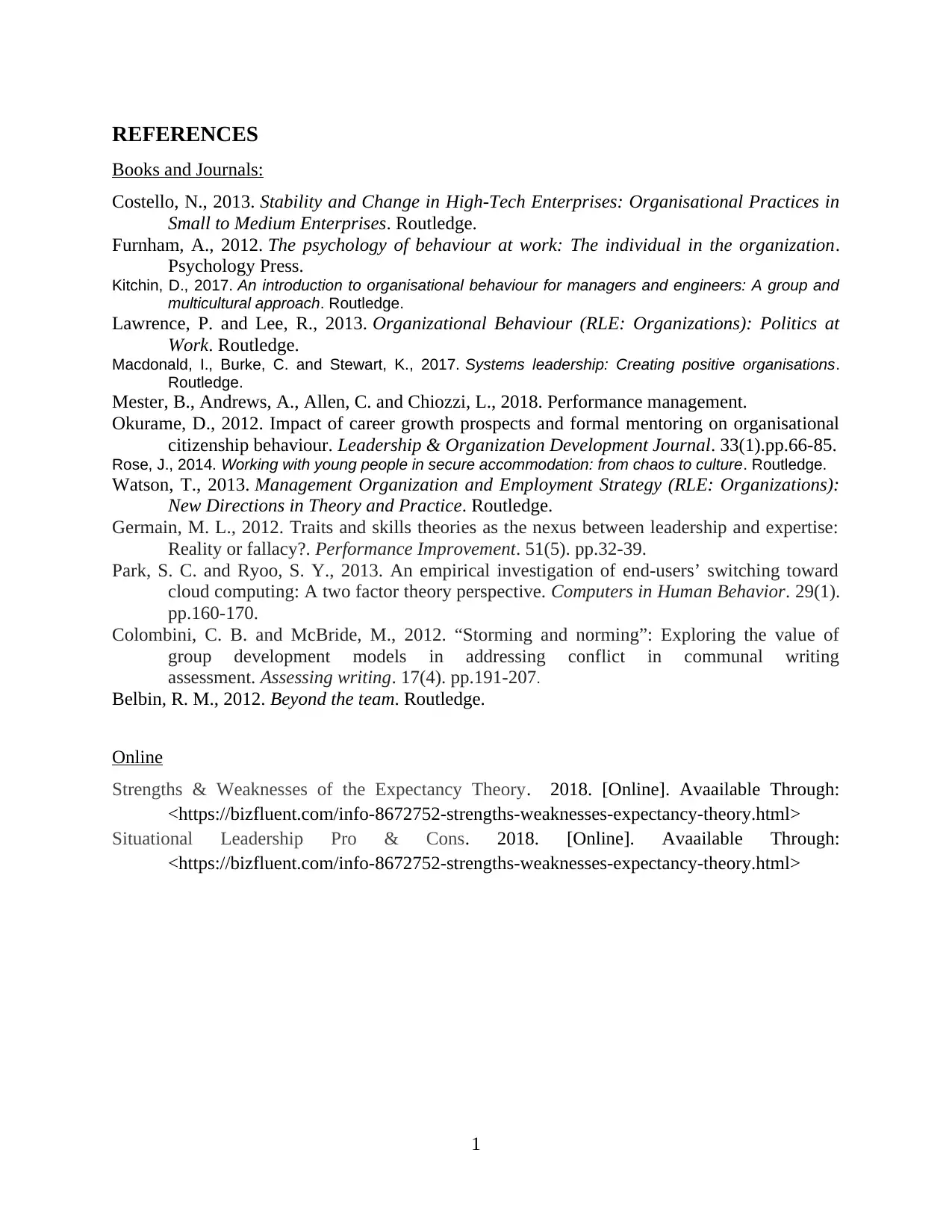
REFERENCES
Books and Journals:
Costello, N., 2013. Stability and Change in High-Tech Enterprises: Organisational Practices in
Small to Medium Enterprises. Routledge.
Furnham, A., 2012. The psychology of behaviour at work: The individual in the organization.
Psychology Press.
Kitchin, D., 2017. An introduction to organisational behaviour for managers and engineers: A group and
multicultural approach. Routledge.
Lawrence, P. and Lee, R., 2013. Organizational Behaviour (RLE: Organizations): Politics at
Work. Routledge.
Macdonald, I., Burke, C. and Stewart, K., 2017. Systems leadership: Creating positive organisations.
Routledge.
Mester, B., Andrews, A., Allen, C. and Chiozzi, L., 2018. Performance management.
Okurame, D., 2012. Impact of career growth prospects and formal mentoring on organisational
citizenship behaviour. Leadership & Organization Development Journal. 33(1).pp.66-85.
Rose, J., 2014. Working with young people in secure accommodation: from chaos to culture. Routledge.
Watson, T., 2013. Management Organization and Employment Strategy (RLE: Organizations):
New Directions in Theory and Practice. Routledge.
Germain, M. L., 2012. Traits and skills theories as the nexus between leadership and expertise:
Reality or fallacy?. Performance Improvement. 51(5). pp.32-39.
Park, S. C. and Ryoo, S. Y., 2013. An empirical investigation of end-users’ switching toward
cloud computing: A two factor theory perspective. Computers in Human Behavior. 29(1).
pp.160-170.
Colombini, C. B. and McBride, M., 2012. “Storming and norming”: Exploring the value of
group development models in addressing conflict in communal writing
assessment. Assessing writing. 17(4). pp.191-207.
Belbin, R. M., 2012. Beyond the team. Routledge.
Online
Strengths & Weaknesses of the Expectancy Theory. 2018. [Online]. Avaailable Through:
<https://bizfluent.com/info-8672752-strengths-weaknesses-expectancy-theory.html>
Situational Leadership Pro & Cons. 2018. [Online]. Avaailable Through:
<https://bizfluent.com/info-8672752-strengths-weaknesses-expectancy-theory.html>
1
Books and Journals:
Costello, N., 2013. Stability and Change in High-Tech Enterprises: Organisational Practices in
Small to Medium Enterprises. Routledge.
Furnham, A., 2012. The psychology of behaviour at work: The individual in the organization.
Psychology Press.
Kitchin, D., 2017. An introduction to organisational behaviour for managers and engineers: A group and
multicultural approach. Routledge.
Lawrence, P. and Lee, R., 2013. Organizational Behaviour (RLE: Organizations): Politics at
Work. Routledge.
Macdonald, I., Burke, C. and Stewart, K., 2017. Systems leadership: Creating positive organisations.
Routledge.
Mester, B., Andrews, A., Allen, C. and Chiozzi, L., 2018. Performance management.
Okurame, D., 2012. Impact of career growth prospects and formal mentoring on organisational
citizenship behaviour. Leadership & Organization Development Journal. 33(1).pp.66-85.
Rose, J., 2014. Working with young people in secure accommodation: from chaos to culture. Routledge.
Watson, T., 2013. Management Organization and Employment Strategy (RLE: Organizations):
New Directions in Theory and Practice. Routledge.
Germain, M. L., 2012. Traits and skills theories as the nexus between leadership and expertise:
Reality or fallacy?. Performance Improvement. 51(5). pp.32-39.
Park, S. C. and Ryoo, S. Y., 2013. An empirical investigation of end-users’ switching toward
cloud computing: A two factor theory perspective. Computers in Human Behavior. 29(1).
pp.160-170.
Colombini, C. B. and McBride, M., 2012. “Storming and norming”: Exploring the value of
group development models in addressing conflict in communal writing
assessment. Assessing writing. 17(4). pp.191-207.
Belbin, R. M., 2012. Beyond the team. Routledge.
Online
Strengths & Weaknesses of the Expectancy Theory. 2018. [Online]. Avaailable Through:
<https://bizfluent.com/info-8672752-strengths-weaknesses-expectancy-theory.html>
Situational Leadership Pro & Cons. 2018. [Online]. Avaailable Through:
<https://bizfluent.com/info-8672752-strengths-weaknesses-expectancy-theory.html>
1

2
⊘ This is a preview!⊘
Do you want full access?
Subscribe today to unlock all pages.

Trusted by 1+ million students worldwide
1 out of 12
Related Documents
Your All-in-One AI-Powered Toolkit for Academic Success.
+13062052269
info@desklib.com
Available 24*7 on WhatsApp / Email
![[object Object]](/_next/static/media/star-bottom.7253800d.svg)
Unlock your academic potential
Copyright © 2020–2025 A2Z Services. All Rights Reserved. Developed and managed by ZUCOL.





